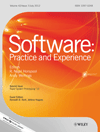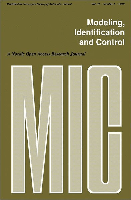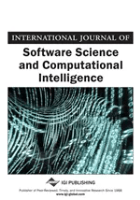
Innovations in Systems and Software Engineering
Scope & Guideline
Shaping Tomorrow's Software Solutions Today
Introduction
Aims and Scopes
- Software Engineering Methodologies:
The journal emphasizes new methodologies in software engineering, including agile approaches, model-driven engineering, and hybrid algorithms that enhance software development processes. - Machine Learning and AI Applications:
There is a strong focus on integrating machine learning and artificial intelligence within software engineering, exploring their applications in areas like defect prediction, performance optimization, and intelligent automation. - Systems Modeling and Verification:
Research on modeling techniques, including formal methods, system dynamics, and Petri nets, is prevalent, contributing to the reliability and safety of software systems. - IoT and Cyber-Physical Systems:
The journal covers innovative solutions and frameworks for Internet of Things (IoT) applications and cyber-physical systems, addressing challenges such as security, scalability, and real-time processing. - Sustainability and Environmental Impact:
Recent publications indicate a growing interest in environmentally sustainable computing and the impact of software engineering practices on ecological systems.
Trending and Emerging
- Deep Learning Applications in Software Engineering:
There is a marked increase in the application of deep learning techniques across various domains within software engineering, including defect prediction, image processing, and system optimization. - Proactive Security Measures:
Recent publications emphasize proactive security measures, particularly in IoT and cyber-physical systems, indicating a growing focus on threat detection, risk management, and resilience in software design. - Context-Aware Computing:
Research on context-aware computing is emerging, particularly in IoT and smart environments, highlighting its potential for enhancing user experiences and system efficiencies. - Sustainable Computing Practices:
The trend towards sustainability is evident, with an increase in studies addressing the environmental impacts of software engineering practices and exploring eco-friendly solutions. - Integration of Blockchain Technology:
Blockchain technology is increasingly featured in recent publications, particularly in relation to secure data management and supply chain applications, showcasing its growing relevance in systems engineering.
Declining or Waning
- Traditional Software Testing Techniques:
There has been a noticeable decrease in papers focusing solely on traditional software testing techniques. The shift towards automated and AI-driven testing methods indicates a transition to more advanced practices. - Basic Data Mining Techniques:
The frequency of publications centered around fundamental data mining techniques has decreased as more sophisticated machine learning methods and hybrid approaches are gaining traction. - Classical Requirements Engineering Approaches:
Research focusing on classical requirements engineering seems to be waning as newer methodologies, including agile and model-driven approaches, become more prominent in the literature. - Static Analysis Tools:
There appears to be a decline in the exploration of static analysis tools for software verification, with a growing emphasis on dynamic and hybrid analysis methods in recent studies.
Similar Journals

University Politehnica of Bucharest Scientific Bulletin Series C-Electrical Engineering and Computer Science
Empowering Researchers to Illuminate the Future of TechnologyThe University Politehnica of Bucharest Scientific Bulletin Series C-Electrical Engineering and Computer Science is an esteemed academic journal dedicated to advancing knowledge in the fields of electrical engineering and computer science. Published by POLYTECHNIC UNIV BUCHAREST, this journal serves as a vital platform for researchers and professionals to share their innovative findings and insights. With an ISSN of 2286-3540 and an E-ISSN of 2286-3559, it has been a beacon of scholarly communication since its inception in 2008. Though currently categorized in Q4 in Electrical and Electronic Engineering, the journal is committed to enhancing its impact within the academic community and industry by fostering research that bridge gaps between theory and practical application. Operating from Romania, the journal emphasizes open access for its readership, ensuring wide dissemination of its content. Researchers, professionals, and students are encouraged to contribute and explore groundbreaking studies, as this journal aims to elevate the discourse and innovation in engineering and computer science.

Journal of Object Technology
Navigating the Evolving Landscape of Software EngineeringJournal of Object Technology is a premier publication housed under the esteemed JOURNAL OBJECT TECHNOLOGY in Switzerland, dedicated to advancing the field of software engineering and technology. With a history of continuous publication since 2002, this journal serves as a platform for innovative research, critical reviews, and case studies that explore the nuances of object-oriented technologies and their applications in software development. Although currently categorized in the lower quartile (Q4), this journal's focus on relevant and emerging topics remains vital for researchers, professionals, and students alike, seeking to enhance their understanding of contemporary software-related issues. Addressing significant milestones and offering insights into future directions, the Journal of Object Technology plays an essential role in the evolving landscape of computer science, providing open access opportunities that ensure wide dissemination of knowledge. Situated at ETH Zurich, the journal is committed to fostering collaboration and dialogue among researchers worldwide, underscoring its importance within the global scholarly community.

SOFTWARE-PRACTICE & EXPERIENCE
Bridging academic rigor and practical experience in software development.SOFTWARE-PRACTICE & EXPERIENCE, published by Wiley, is a prestigious journal that has significantly contributed to the field of software engineering since its inception in 1971. With a Q2 ranking in Software according to the 2023 category quartiles, it stands among the top tier of journals, positioned in the 79th percentile within Scopus’s Computer Science _ Software category. The journal focuses on disseminating high-quality research that reflects both academic rigour and practical application in software-related practices, ensuring that it remains relevant for researchers, professionals, and students alike. Although it does not currently offer Open Access options, it continues to provide invaluable insights and thorough explorations of contemporary issues in software development, methodology, and experience. As it converges toward 2024, SOFTWARE-PRACTICE & EXPERIENCE aims to foster a greater understanding of effective software practices in a rapidly evolving technological landscape.

Applied Computer Systems
Advancing the Frontiers of Applied ComputingApplied Computer Systems is a distinguished journal published by SCIENDO, specializing in the dynamic field of computer science and technology. With the ISSN 2255-8683 and E-ISSN 2255-8691, this Open Access journal has been committed to disseminating high-quality research since 2008, ensuring global accessibility for researchers and practitioners alike. Hailing from Warsaw, Poland, the journal serves as a crucial platform for innovative studies that delve into applied computing methodologies and their diverse applications across industries. By maintaining rigorous peer-review standards, Applied Computer Systems supports the advancement of knowledge in computing, making it an essential resource for students, professionals, and academics seeking to stay at the forefront of technological progress. Engage with a community dedicated to exploring the integration of computer systems in a rapidly evolving digital landscape.

MODELING IDENTIFICATION AND CONTROL
Empowering Innovation in Modeling and SimulationMODELING IDENTIFICATION AND CONTROL is a prominent academic journal dedicated to the fields of Computer Science Applications, Control and Systems Engineering, Modeling and Simulation, and Software. Published by MIC in Norway, this open access journal has been providing valuable insights and innovative research since 1980, promoting the free dissemination of knowledge. With a reputation reflected in its 2023 quartile rankings—Q3 in Computer Science Applications, Q2 in Control and Systems Engineering, and Modeling and Simulation, as well as Q3 in Software—this journal plays a vital role in advancing theoretical and practical solutions within its disciplines. Researchers and professionals benefit from its rigorous peer-review process and impactful publications, fostering collaboration and the exploration of emerging technologies across various applications. The journal's continual commitment to excellence is exemplified by its active presence in Scopus, where it maintains respectable rankings in relevant engineering and computer science subcategories, supporting its goal to be a pivotal resource for scholarly communication and practical advancements.

International Journal of Software Science and Computational Intelligence-IJSSCI
Advancing the Frontiers of Software Science and IntelligenceInternational Journal of Software Science and Computational Intelligence (IJSSCI) is a prominent academic journal published by IGI Global, dedicated to advancing the fields of software science and computational intelligence. With its ISSN 1942-9045 and E-ISSN 1942-9037, IJSSCI offers a platform for researchers, practitioners, and students to disseminate innovative research findings, theoretical advancements, and practical applications in areas such as algorithm development, machine learning, and software engineering. Although the journal currently does not operate under an open access model, its rigorous peer-review process ensures high-quality publications that contribute significantly to the academic discourse. Based in Hershey, PA, IJSSCI is recognized for its commitment to fostering collaboration among professionals in the technology and computer science fields, making it an essential resource for those looking to stay at the forefront of software science advancements.

SOFTWARE QUALITY JOURNAL
Elevating standards in software quality assurance.SOFTWARE QUALITY JOURNAL, published by Springer, is a preeminent platform dedicated to advancing the field of software engineering and quality assurance. With an ISSN of 0963-9314 and an E-ISSN of 1573-1367, this journal serves as a vital resource for academics and practitioners alike, bridging the gap between theoretical frameworks and practical applications. The journal is recognized for its impactful contributions, holding a remarkable Q1 ranking in Media Technology and demonstrating strong performance with Q2 placements in Safety, Risk, Reliability and Quality, as well as Software, solidifying its reputation in the academic community. As of 2023, the journal is ranked 64th in Safety, Risk, Reliability and Quality and 176th in Computer Science Software on Scopus, showcasing its relevance and influence. Covering a broad range of topics from software quality metrics to risk management strategies, SOFTWARE QUALITY JOURNAL aims to foster innovation and best practices in software development. Join a community of leading researchers and professionals committed to enhancing the quality and reliability of software systems.

ACM TRANSACTIONS ON SOFTWARE ENGINEERING AND METHODOLOGY
Shaping the Future of Software Through Rigorous MethodologyACM Transactions on Software Engineering and Methodology, published by the Association for Computing Machinery, is a leading journal in the field of software engineering, featuring cutting-edge research and methodologies that influence practices and advancements in the discipline. Established in 1992, this journal boasts an impressive Q1 ranking in Software for the year 2023, signaling its high impact and relevance within the academic community. With its strong Scopus rank (#126/407) and a solid 69th percentile, it serves as a critical platform for scholars, practitioners, and students alike, promoting the dissemination of innovative ideas and solutions that drive the software industry forward. Although it operates without an open access option, it consistently publishes peer-reviewed articles, technological advancements, and case studies that shape the future of software engineering. The journal's commitment to quality and excellence makes it an essential read for anyone keen on understanding the complexities and methodologies transforming the field.

SCIENCE OF COMPUTER PROGRAMMING
Fostering Collaboration for a Dynamic Technological LandscapeScience of Computer Programming, published by Elsevier, is a leading journal dedicated to advancing knowledge in the fields of computer programming, computational theory, and software development. With a focus on interdisciplinary research that spans computational methodologies, information systems, and simulation modeling, this journal plays a vital role in disseminating innovative findings and fostering collaboration among experts in these dynamic areas. With a respectable impact factor and ranked in various Scopus Categories such as computational theory (Q3) and information systems (Q2), it provides a platform for high-quality scholarly articles that push the boundaries of programming science. Although currently not open access, the journal offers invaluable insights for researchers, professionals, and students alike, ensuring they are equipped with the latest advancements and methodologies to thrive in an ever-evolving technological landscape. The journal covers research from its convergence starting in 1981 and continues to welcome groundbreaking contributions as it looks forward to an exciting future through 2025 and beyond.

EMPIRICAL SOFTWARE ENGINEERING
Unveiling the truths of software systems through empirical studies.Empirical Software Engineering is a leading journal published by Springer, dedicated to advancing the science and practice of software engineering through empirical research. With an impressive impact factor in the Q1 quartile of the Software category and a Scopus ranking of #76 out of 407 journals, it occupies a prominent position within the field, attracting high-quality submissions from around the globe. Since its inception in 1996, the journal has provided a vital platform for disseminating critical findings that drive the evolution of software development methodologies and practices. While it is not an open-access journal, its rigorous peer-review process ensures that only the most impactful research reaches its readership, making it an essential resource for researchers, professionals, and students looking to stay at the forefront of software engineering innovations. Based in the Netherlands at Van Godewijckstraat 30, 3311 GZ Dordrecht, Empirical Software Engineering continues to set the standard for quality and significance in empirical studies of software systems and processes.